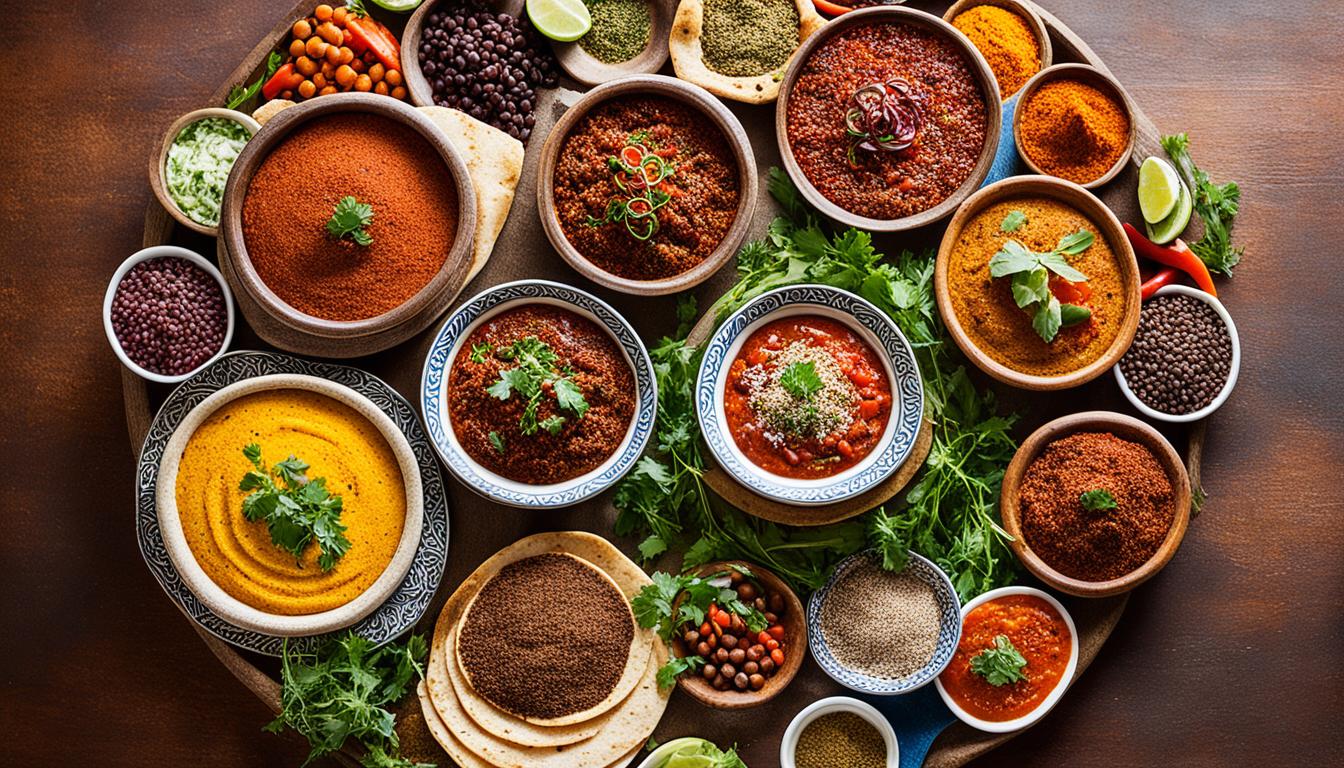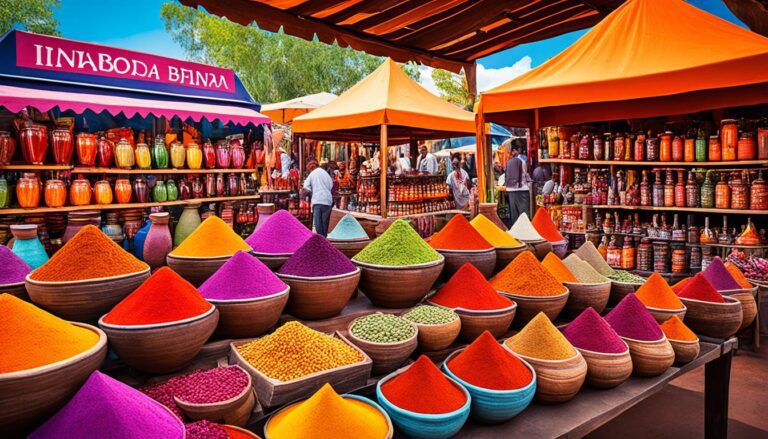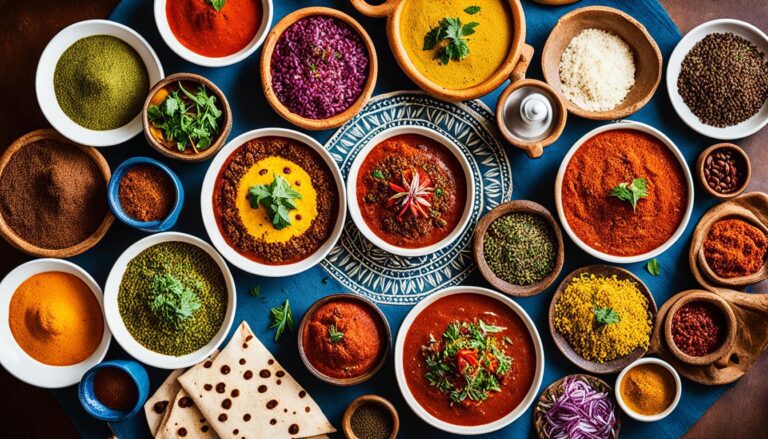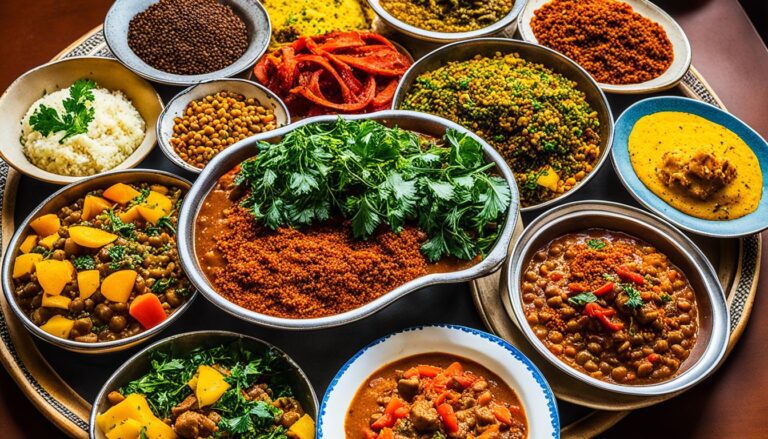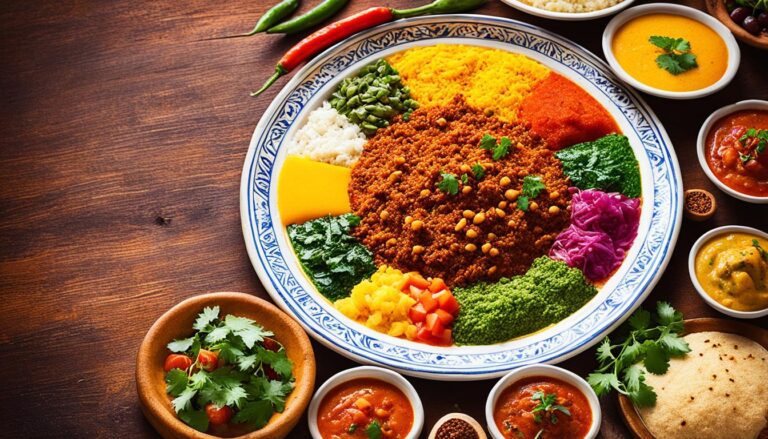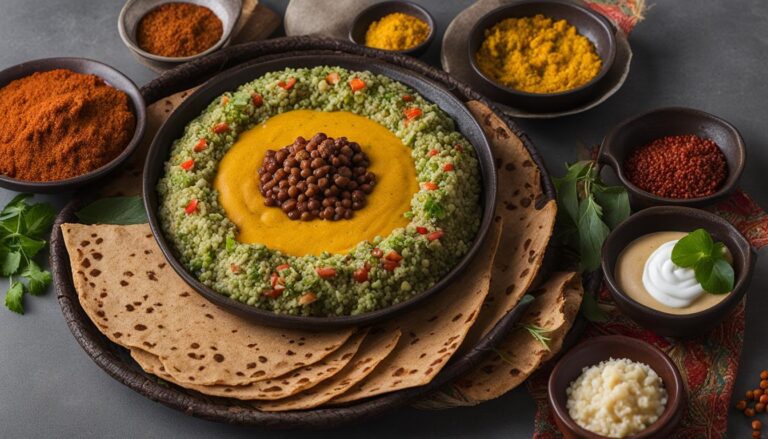What Is Good Ethiopian Food?
Are you ready to embark on a culinary journey that will tantalize your taste buds with vibrant flavors? Let’s explore the world of Ethiopian food, a cuisine that is as diverse as it is delicious. From communal dining to bold spices and unique dishes, Ethiopian food offers a cultural and gastronomic experience like no other.
Key Takeaways:
- Ethiopian food is known for its vibrant flavors and rich cultural heritage.
- Injera, a spongy pancake-like bread, is the foundation of most Ethiopian meals.
- Bold spices like berbere and mitmita add depth and complexity to Ethiopian dishes.
- There are plenty of vegetarian and vegan options in Ethiopian cuisine.
- Communal dining and the tradition of gursha make Ethiopian food a social and interactive experience.
The Significance of Injera in Ethiopian Cuisine
Injera, the traditional Ethiopian bread, holds immense significance in Ethiopian cuisine. It is made from teff, a gluten-free grain indigenous to Ethiopia. The process begins by grinding the teff into flour, which is then combined with water and left to ferment for a period of time. This fermentation process gives injera its unique sour taste and soft, spongy texture.
After the fermentation process, the injera batter is poured onto a hot skillet or griddle, where it is cooked until bubbles form on the surface. The end result is a large, round pancake-like bread, which serves as the foundation for most Ethiopian meals.
Injera not only adds texture and flavor to the dishes but also plays a crucial role in the communal dining culture of Ethiopia. When served, various stews, curries, and vegetables are placed on top of the injera, creating a colorful and vibrant meal. The injera acts as a utensil, as diners tear off pieces and use them to scoop up the flavorful dishes.
One of the remarkable aspects of injera is its nutritional value. The fermentation process increases the bioavailability of nutrients in teff, making it rich in vitamins, minerals, and beneficial microorganisms. Injera is also gluten-free, making it an excellent choice for individuals with gluten sensitivities or celiac disease.
With its versatility, unique flavor profile, and cultural significance, injera truly embodies the essence of Ethiopian cuisine. It not only satisfies the appetite but also brings people together to share a delicious and communal dining experience.
Exploring the Flavors of Ethiopian Food
Ethiopian cuisine is celebrated for its rich and vibrant flavors, which are a result of the diverse and aromatic spices used in its dishes. The use of Ethiopian spices such as berbere, mitmita, awaze, and niter kibbeh adds a unique depth of flavor to the cuisine.
Berbere is a popular spice mix that forms the backbone of many Ethiopian dishes. It is a blend of chili powder, fenugreek, ginger, garlic, cardamom, and cinnamon, among other spices. The combination of these ingredients creates a fiery and aromatic spice mix that adds a distinct taste to stews, lentil dishes, and grilled meats.
Mitmita is a spicier blend of dry spices that is frequently used as a side accompaniment to enhance the flavor of a dish. It typically includes spices such as chili peppers, cardamom, cloves, black pepper, and salt. Mitmita adds a kick to various Ethiopian dishes, intensifying the overall flavor profile.
Awaze is a paste made from berbere mixed with oil and Ethiopian wine or whiskey. It is commonly served with meat dishes, particularly those cooked on the grill. The combination of the berbere spice mix and the tanginess of the wine or whiskey creates a robust and savory condiment that perfectly complements the flavors of the grilled meat.
Niter kibbeh, also known as Ethiopian butter, is a clarified butter infused with various spices. Fenugreek, cumin, and turmeric are commonly used to give niter kibbeh its distinct flavor. This rich and aromatic butter is a key ingredient in many Ethiopian dishes, adding a smooth and buttery taste to stews, sautéed vegetables, and sauces.
From the bold and complex flavors of berbere to the fiery kick of mitmita and the aromatic richness of awaze and niter kibbeh, these Ethiopian spices elevate the cuisine, creating a taste that is truly unique to the region.
Ethiopian Food: A Vegetarian’s Delight
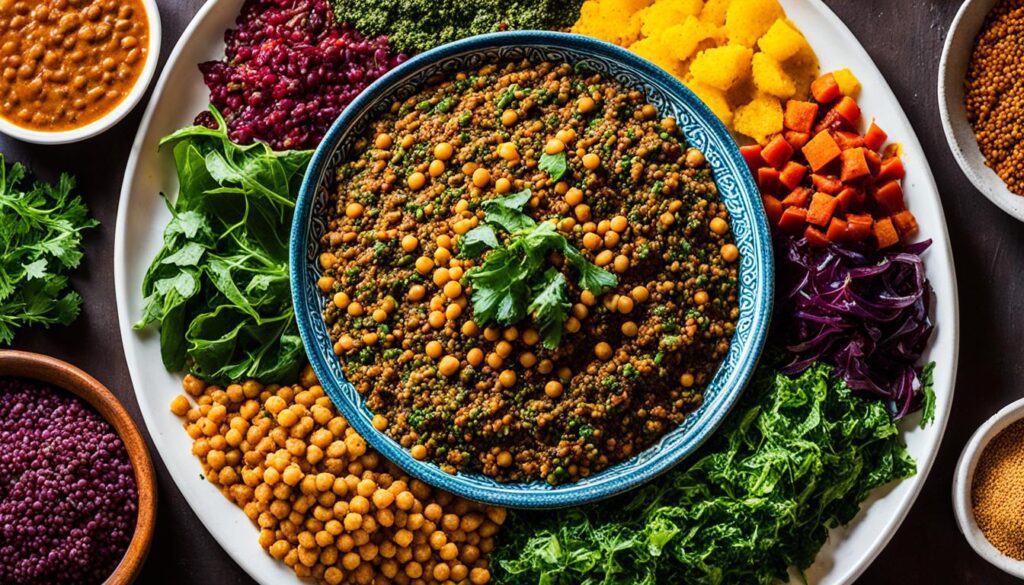
Ethiopian cuisine offers a wide range of delectable options for vegetarians and vegans. Whether you follow a plant-based diet or simply enjoy meatless meals occasionally, you’ll find that Ethiopian food caters to your preferences with delicious and nutritious offerings.
On Wednesdays and Fridays, as well as during the lent period in the Ethiopian Orthodox faith, fasting days are observed. During these days, only vegan food is consumed, making Ethiopian cuisine an ideal choice for those looking for vegetarian options. The emphasis on legume stews, vibrant vegetables, and the staple bread, injera, ensures that vegetarians and vegans can delight in a variety of flavorful dishes.
Among the popular vegetarian dishes in Ethiopian cuisine is shiro wat, a spicy and hearty chickpea stew. Made with a blend of spices, onions, and garlic, it is the perfect comfort food. Another vegetarian favorite is misir wat, a fragrant and savory red lentil stew. The combination of spices and the creaminess of the lentils make it an irresistible choice. For a refreshing accompaniment, salata, a simple yet flavorful tomato salad, is commonly served.
Ethiopian cuisine’s emphasis on legumes, fresh vegetables, and injera as a nutritious base ensures that vegetarians and vegans have ample options to enjoy. The diverse flavors and textures of the vegetarian dishes will tantalize your taste buds and keep you coming back for more.
Experience the Unique Dining Culture of Ethiopia
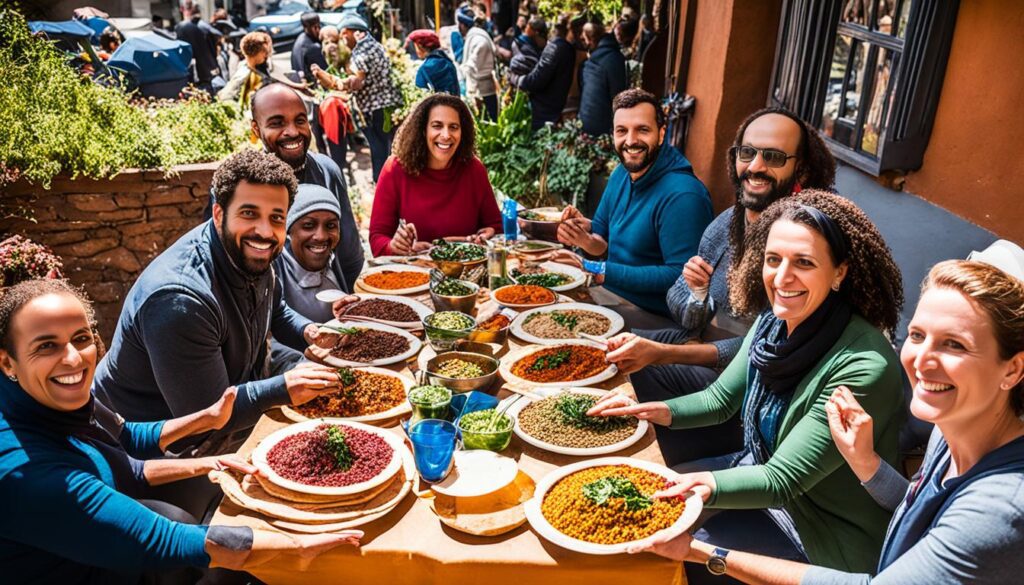
When it comes to Ethiopian food, it’s not just about the incredible flavors; it’s also about the rich dining culture and traditions that accompany each meal. In Ethiopia, meals are more than just sustenance – they are a social and interactive experience that fosters connection and togetherness.
Communal eating is a significant part of Ethiopian dining culture. Meals are typically shared with friends and family, creating an atmosphere of warmth and hospitality. Food is served on a communal platter called a gebeta, which is placed in the center of the table. This arrangement encourages everyone to come together and enjoy the feast, reinforcing the bonds of kinship and camaraderie.
An essential aspect of Ethiopian dining culture is the practice of gursha. Gursha involves feeding each other bites of food as a gesture of respect and love. This tradition symbolizes the strong sense of community and unity in Ethiopian society. It is common for family members and friends to take turns feeding one another, creating an intimate and joyful atmosphere.
At the heart of this dining experience is injera, the traditional Ethiopian bread. Injera serves as a platform for the communal meal, with individuals tearing off pieces of injera and using them to scoop up the various flavorsome dishes placed on the gebeta. The soft and spongy texture of injera, combined with the diverse flavors of Ethiopian cuisine, makes every bite a delight for the senses.
As you immerse yourself in the Ethiopian dining culture, you will not only indulge in the delicious food but also experience the warmth and hospitality of the Ethiopian people. The communal eating and gursha rituals create a unique and memorable atmosphere that is sure to leave a lasting impression.
So, embrace the Ethiopian dining experience, gather your loved ones around the gebeta, and savor the vibrant flavors of this extraordinary culinary tradition.
Must-Try Ethiopian Dishes
There are numerous delicious dishes to explore in Ethiopian cuisine. From rich stews to flavorful salads, each dish offers its own unique experience that contributes to the vibrant tapestry of Ethiopian flavors.
-
Shiro Wat
Shiro wat is a staple dish made from chickpea and broad bean flour. It is commonly served with injera, the traditional Ethiopian bread. The combination of the savory stew and spongy injera creates a delightful blend of flavors and textures.
-
Misir Wat
Misir wat is a red lentil stew that is a popular choice among vegetarians. The lentils are cooked with aromatic spices, creating a warm and hearty dish. It is often enjoyed with injera or rice.
-
Doro Wat
Doro wat is a must-try non-vegetarian dish that features chicken stew cooked with berbere spice and Ethiopian butter. The combination of tender chicken, rich spices, and fragrant butter creates a mouthwatering dish that is often served with injera or rice.
-
Salata
Salata refers to the refreshing tomato salad commonly found in Ethiopian cuisine. It is made with fresh tomatoes, onions, and a tangy dressing. The crisp and vibrant flavors of salata make it a perfect complement to the robust dishes of Ethiopian cuisine.
-
Chechebsa
Chechebsa is a fried bread dish that is often enjoyed for breakfast or brunch. The bread is deep-fried and seasoned with spices, creating a crispy and flavorful treat. It can be eaten on its own or paired with honey or spiced butter.
-
Fit Fit
Fit fit is a dish that uses marinated injera as its main ingredient. The injera is torn into pieces, mixed with spices, and sautéed until it absorbs the flavors. Fit fit is a hearty and satisfying dish that showcases the versatility of injera.
Conclusion
Embarking on a culinary adventure through Ethiopian cuisine offers a truly immersive and unforgettable experience. From the vibrant flavors of injera, the communal dining culture, to the diverse array of dishes, Ethiopian food encompasses a rich cultural immersion that appeals to all tastes. Whether you have a penchant for vegetarian delights or savor meaty indulgences, Ethiopian cuisine caters to everyone’s preferences.
By embracing Ethiopian food, we not only tantalize our taste buds but also gain a deeper understanding and appreciation for the cultural heritage of Ethiopia. The shared act of eating from a communal platter and feeding each other gursha bites creates a sense of togetherness and fosters connections. It is an opportunity to bond with friends and family while engaging in a unique and interactive dining experience.
So, let’s step into an Ethiopian restaurant with confidence, and allow ourselves to be transported to the enchanting world of Ethiopian flavors. Indulge in the diverse spices, savor the unique textures, and allow the richness of the cuisine to envelop your senses. Whether it’s injera paired with fragrant stews, crisp vegetable dishes, or aromatic coffee, every bite is a gateway to Ethiopian culture, taking us on a gastronomic journey that brings us closer to the heart of this vibrant and captivating country.

